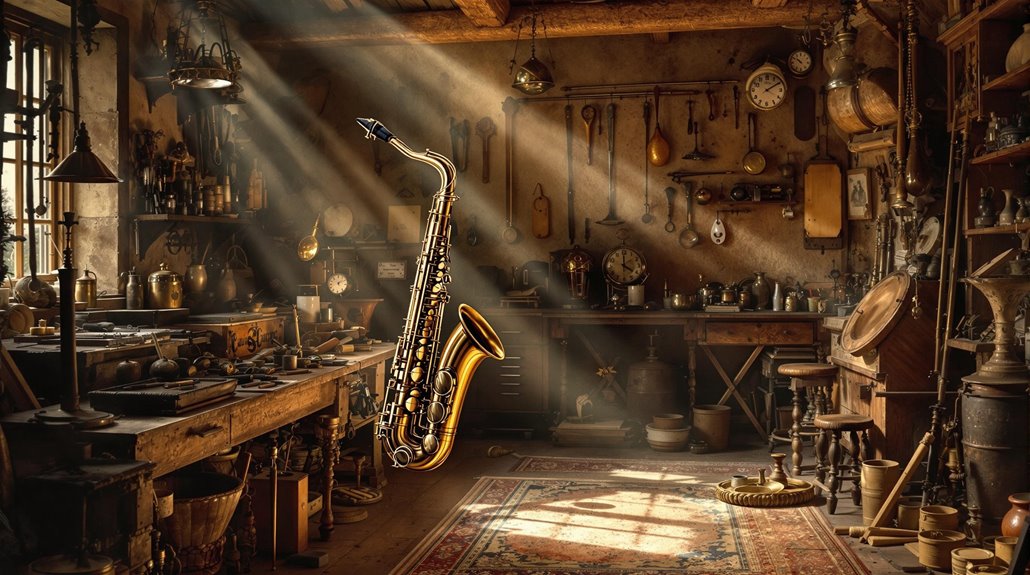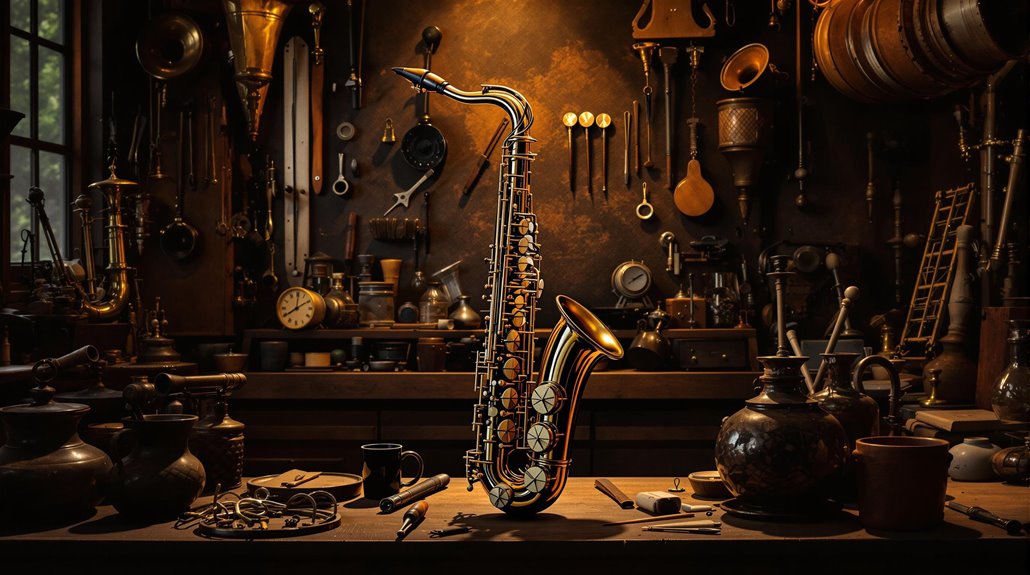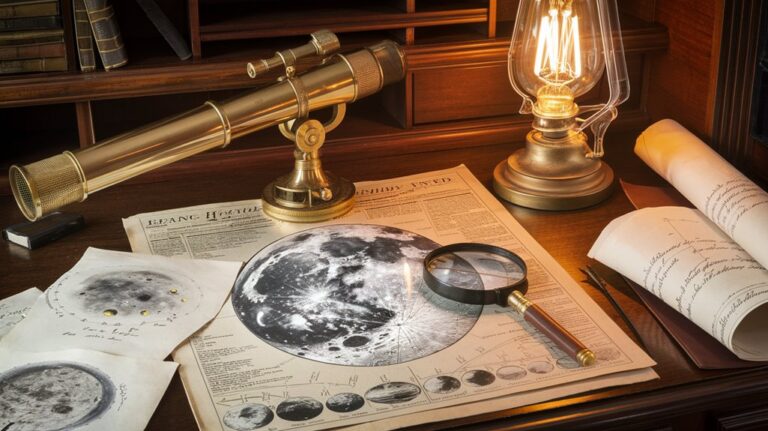Adolphe Sax: The Accident-Prone Genius Behind the Saxophone
Did you know that nearly 90% of all jazz ensembles today feature at least one saxophone? Yet this iconic instrument might never have existed if its inventor had succumbed to any of his numerous childhood accidents. You've probably heard the smooth sounds of a saxophone, but you won't believe the story of Adolphe Sax, who survived falls, poisonings, and explosions before revolutionizing music forever. His remarkable journey from accident-prone child to musical innovator reveals an extraordinary tale of persistence.
The Nine Lives of Young Adolphe
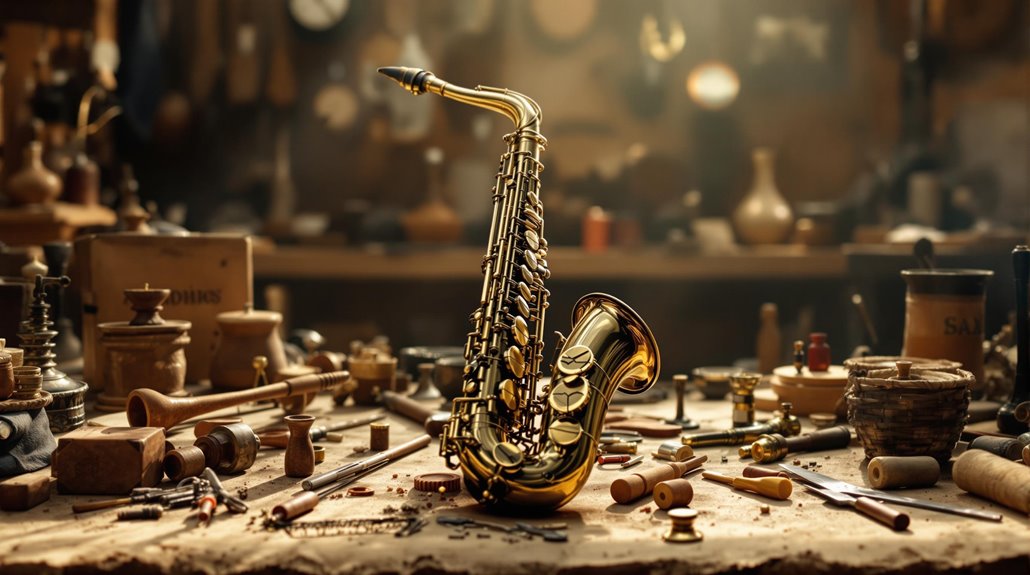
At least seven near-fatal accidents plagued Adolphe Sax's childhood, earning him the nickname "little Sax, the ghost" among concerned neighbors. You wouldn't believe the series of mishaps: he fell from a third-floor window, drank acid, swallowed a pin, and suffered severe burns from both gunpowder and a hot frying pan. His childhood resilience was truly remarkable. Being raised in Belgian culture would influence his future tastes and perspectives.
If you're counting his brushes with death, don't forget the time a cobblestone struck his head before he fell into a river, or his three separate encounters with toxic varnish fumes.
His mother even declared him "condemned to misfortune," certain he wouldn't survive. Yet this extraordinary accident survival record shaped his future – the boy who seemed destined for tragedy would instead revolutionize music forever. Growing up in a family where his parents were instrument designers, young Adolphe was destined to follow their creative path despite his misfortunes.
From Musical Prodigy to Innovative Designer
The roots of Sax's musical genius traced back to his childhood in Dinant, Belgium, where his father's instrument workshop became his earliest classroom. His musical education at the Brussels Conservatory, combined with hands-on craftsmanship experience, laid the foundation for his innovative spirit. Despite his talent, he faced numerous near-death experiences throughout his youth. Under the guidance of his father Charles Joseph Sax, he learned the fundamentals of instrument making.
By age 15, you'd have found young Adolphe already crafting sophisticated instruments, showcasing his remarkable talents through:
- Building intricate ivory clarinets and flutes
- Winning prestigious industrial exposition prizes
- Mastering both performance and instrument design
This unique blend of musical prowess and technical skill propelled him to revolutionize instrument design.
At just 24, he transformed the bass clarinet, setting the stage for his most famous creation – the saxophone. His innovative spirit drove him to challenge conventional instrument design, forever changing the landscape of music.
Birth of the Saxophone: A Musical Revolution
Building on his early successes, Sax released his masterpiece during the early 1840s in Paris – the revolutionary saxophone. This musical innovation bridged the gap between woodwind and brass instruments, combining a clarinet mouthpiece with an ophicleide-like brass body.
After winning a legal dispute, he secured the patent on June 28, 1846.
The saxophone's evolution began with 14 different versions in two categories, starting with the baritone prototype. You'll find that unlike the clarinet's twelfth, Sax designed his instrument to overblow at the octave. Though originally crafted from wood materials, Sax later switched to brass for better durability and sound projection.
While renowned composers like Berlioz, Rossini, and Bizet championed the instrument, many classical circles remained skeptical. Despite facing numerous lawsuits and patent challenges, Sax's invention quickly found its place in French army bands and outdoor ensembles. Teaching of the instrument commenced at major music institutions in 1847, with the first graduating class achieving honors that same year.
Beyond the Saxophone: Other Remarkable Inventions
While most people know Adolphe Sax for his namesake saxophone, his inventive genius extended far beyond this famous creation.
His prolific mind gave birth to the Saxhorns, whose significance in shaping modern brass bands can't be overstated. You'll find these versatile instruments still enriching concert bands and orchestras today. He established his reputation with a workshop in Paris that produced an impressive 20,000 instruments.
The Saxotrombas evolution marked another innovative step, though shorter-lived, featuring a narrower bore than their saxhorn cousins. Despite experiencing three bankruptcies, he continued innovating and creating new instruments throughout his career.
Beyond these, Sax's creative spirit produced:
- The Saxtubas, designed to expand orchestral possibilities across multiple registers
- An improved bass clarinet design at just 24 years old
- The ambitious Saxotonnerre, a locomotive-powered organ that pushed engineering boundaries
His 46 patents demonstrate a restless innovative spirit that transformed the musical landscape well beyond his most famous creation.
Triumphs and Trials in 19th Century Paris
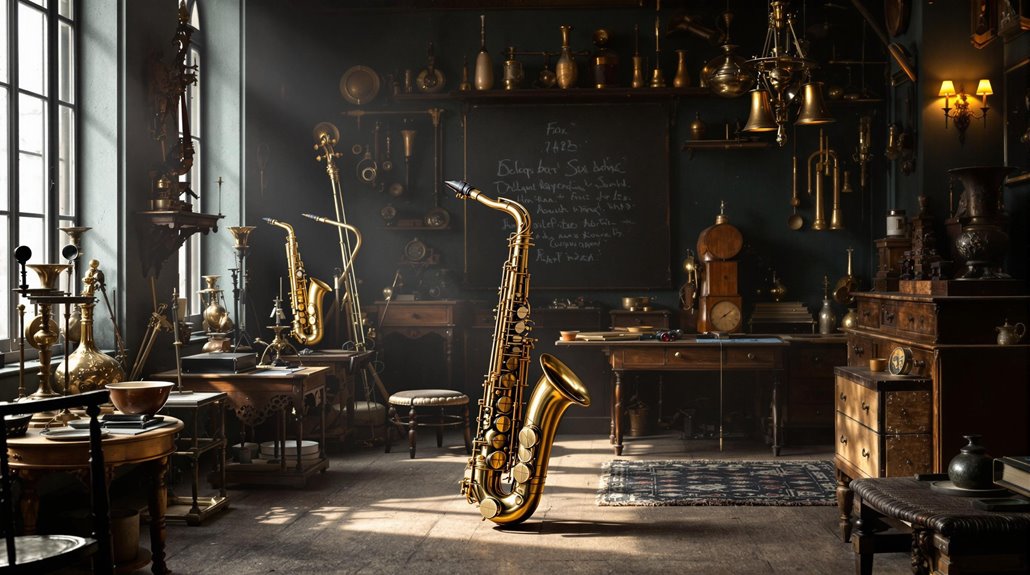
Moving from his inventive achievements to his Parisian chapter, Sax's journey in the French capital proved both exhilarating and tumultuous.
After establishing his workshop on rue Saint-Georges in 1843, he quickly gained recognition for his exceptional woodwind and brass instruments. Musical advocacy from influential figures like Hector Berlioz, who praised Sax's genius in the Journal des débats, helped cement his reputation. The instrument's unique design as a brass and woodwind hybrid made it revolutionary for its time. His achievements were particularly impressive considering he had survived numerous childhood accidents that nearly claimed his life.
Yet success came with fierce opposition.
You'll find that while Sax secured his saxophone patent in 1846 and earned a teaching position at the Paris Conservatory, he faced relentless legal challenges. His rivals attempted to steal his secrets, bribed his employees, and dragged him through a decade of lawsuits.
Despite going bankrupt three times, Sax's resilience and innovations left an indelible mark on musical history.
The Lasting Sound of Sax's Legacy
Long after Adolphe Sax's trials in Paris, his ingenious invention reshaped the landscape of music forever.
A Belgian-born instrument maker, Sax displayed remarkable innovation throughout his career in crafting musical instruments.
The saxophone's versatility revolutionized multiple genres, from military bands to jazz ensembles, while its unique design bridged the gap between woodwind and brass families.
You'll find the cultural impact of Sax's creation in:
- The development of jazz, blues, and rock music across the United States
- Classical compositions and film scores that harness its distinctive sound
- World music traditions that have embraced its expressive capabilities
Today, you can witness the saxophone's influence in museums worldwide, where it stands as a symbol of musical innovation.
From concert halls to street performances, Sax's legacy continues through the countless musicians who've made his invention an integral part of global musical expression.

